INDI Library v2.0.7 is Released (01 Apr 2024)
Bi-monthly release with minor bug fixes and improvements
How to create a cloud sensor for a part of the sky?
Replied by GerardvS on topic How to create a cloud sensor for a part of the sky?
Just recently I did some tests with a simple and cheap IR temperature meter, the same they point at your forehead to check for Covid. Those tests shows a clear difference between a cloud and clear sky. I am not sure if this in the cold wintertime is also the case so more testing has to be done.
Please Log in or Create an account to join the conversation.
Replied by Porchet on topic How to create a cloud sensor for a part of the sky?
so I already have a weather station with an IR sensor that detects clouds, and it works pretty well.
But it's a little fault for me, because it takes the sky above my observatory, but what can happen is to have the value of "no clouds" but to have clouds in the distance or just want to take a picture of an object.
That's why I was thinking of a camera that counts the number of stars and if all of a sudden the number of stars is more than 10% of the beginning, or you decide to take the pictures of your session, it puts in pose, until a better condition.
Please Log in or Create an account to join the conversation.
- Dr. Frank Fleischmann
-

- Offline
- Junior Member
-

- Physicist / Sternwarte Feuerstein / OES GmbH
Replied by Dr. Frank Fleischmann on topic How to create a cloud sensor for a part of the sky?
take a thermal infrared camera with an all sky lens in front of the camera (e.g. a polished stainless steel ball - or gold plated ball.
You will get a cloud image of the total sky. Clouds are warm, and the cloudless sky is very cold.
The attached photo shows a false color photo. of a polished stainless steel ball with "all sky" in the upper part of the ball. Black is lower than -50degC (no clouds), magenta shows light cirrus clouds around horizon, blue more clouds, and green is the countryside around myself, with me at the center.
Best regards
Frank
Interests: nature, technics, astronomy, optics, space
Developments: motor control, sensors, networking, radio detectors astronomy, cameras for spacecrafts
Using: 3m Baader dome, 2m ScopDome, GM4000, EQ8, and homebrewed ones, echelle spectrograph and ... INDI
Please Log in or Create an account to join the conversation.
Replied by GerardvS on topic How to create a cloud sensor for a part of the sky?
You triggered me to do some tests with OpenCV. There are plenty of "object count" examples available.
Thanks for the idea.
Please Log in or Create an account to join the conversation.
Replied by Porchet on topic How to create a cloud sensor for a part of the sky?
So unfortunately I'm terrible at programming.
Otherwise I'll try to do something about it.
That's why I'm asking if anyone has an idea how to do it or knows a way to do it.
And I'm not very good at English.
Please Log in or Create an account to join the conversation.
Replied by GerardvS on topic How to create a cloud sensor for a part of the sky?
I think it is fairly easy to either analyse the guider images or the real images and do a prediction of cloud coverage once the star-count has dropped significantly.
To be continued.....
Please Log in or Create an account to join the conversation.
- Gilles Gagnon
-

- Offline
- Elite Member
-

- Posts: 294
- Thank you received: 54
Replied by Gilles Gagnon on topic How to create a cloud sensor for a part of the sky?
What I am coming at is that a specialized/limited version of the Weather Radio could be built with a narrow FOV MLX90614 that would be put on the same axis and in from of the telescope tube. That could give you a good idea of the cloud cover in the FOV of the telescope, and the standard Weather Radio would give you an idea of the general cloud cover.
Ideally though, an all-sky (thermal?) camera with cloud detection/mapping over the KStars window would be preferred but... that's another story.
Please Log in or Create an account to join the conversation.
Replied by Porchet on topic How to create a cloud sensor for a part of the sky?
That's exactly what I thought of as an idea, so cool !!
The thing, now, it will be finished to integrate into kstars as we do for weather alerts.
But I think that on will have to add an additional camera, but that's not a problem, otherwise.
In all will I will wait impatiently to hear from you.
See you soon
Christophe
Please Log in or Create an account to join the conversation.
Replied by Porchet on topic How to create a cloud sensor for a part of the sky?
Please Log in or Create an account to join the conversation.
- Gilles Gagnon
-

- Offline
- Elite Member
-

- Posts: 294
- Thank you received: 54
Replied by Gilles Gagnon on topic How to create a cloud sensor for a part of the sky?
If you are interested/curious, you can look at the Melexis datasheet for the MLX90614, www.melexis.com/en/documents/documentati...s/datasheet-mlx90614 .
Please Log in or Create an account to join the conversation.
- Gilles Gagnon
-

- Offline
- Elite Member
-

- Posts: 294
- Thank you received: 54
Replied by Gilles Gagnon on topic How to create a cloud sensor for a part of the sky?
s3.cern.ch/inspire-prod-files-9/98f5d2c8...5cadd2963404c8ae5eec
Please Log in or Create an account to join the conversation.
Replied by Porchet on topic How to create a cloud sensor for a part of the sky?
So indeed it looks good, but I admit not having understood all because my English is not as good as before.
Does he put a simple all sky style camera or is it an IR camera?
So the most, it is if you manage to make a correspondence between what the camera detects and manage to say that in 10min it will be covered in kstars.
But I think it's more complicated to set up than a star-counting camera, right?
Please Log in or Create an account to join the conversation.



